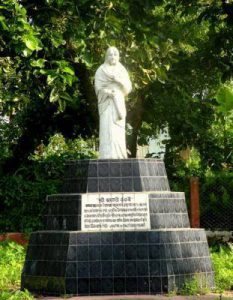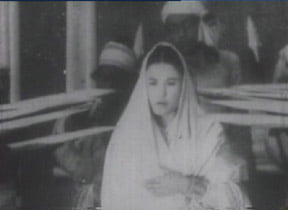Amazons were female warriors of the Eurasian region, whose main concern in life is said to be war; She Wolves are the women who ruled over England before Queen Elizabeth the first. But do you know about the women from the fringes of our country, who have fought valiantly against the atrocities of the autocrats; who tolerated agonizing torture for a better future of their state? Amidst the selective inclusion of women in Indian history, here is an account of Soti Joymoti, a woman whose sacrifice, till date, remains to be an inspiration for the commoners of Assam, and whose story needs to be heard by the people of mainland India, who have remained ignorant of their Queens and princesses for far too long.
Soti Joymoti – an epitome of endurance

Soti Joymoti, also known as Joymoti Konwari, is a celebrated princess for the native Assamese, who honor her courage and endurance.
The state of Assam, then under the Ahom rulers, descendants of the Shan prince, Sukaphaa, was undergoing a tumultuous period between the years of 1671 to 1681, under the rule of many inept kings who were mere puppets at the hands of their Nobles and Prime Ministers. It was at this time that King Gadapani came into power and gained full and strong control over Assam, and reclaimed the region of lower Assam and Guwahati from the hands of the Mughal Emperor, Aurangzeb. But his ascent to the throne would not have been possible without the selfless surrender of his wife, Joymoti.
The Prime Minister to the Lora Raja or boy king Sulikhpaa, Laluksala Borpukan had ordered for all the princes of the Ahom dynasty to be mutilated, a period known as the Purge of the Princes of 1679 to 1681.
The aim was to keep his puppet king on the throne, and so would his power over the ruling of the state. In a situation like this, all the princes of Sukaphaa’s clan were fleeing for their lives. Prince Gadapani, the most obvious heir to the throne, escaped to the Naga hills.
His escape caused a huge ruckus in the court and troops were sent to trace him. When the king’s men failed to find Gadapani’s whereabouts, his wife, Joymoti was called upon, for it was believed that she must be aware of her husband’s whereabouts. Joymoti was subjected to agonizing torture, trying to force her to divulge the hiding place of her husband, but no amount of pressure would budge her. She was tortured for a period of fourteen days, in ‘Jerenga pathar’ in Sivasagar. She was tied to a thorny plant and inhuman physical afflictions were inflicted on her body, on the orders of Laluksala Borpukan. A mother of two, Lai and Lechai, aged 14 and 12, Joymoti was pregnant at the time, she endured the torture for fourteen days, ultimately dying at the hands of Lora Raja’s men. The courageous woman that she was, Joymoti did not reveal Gadapani’s lair, keeping mum throughout the period of her horrendous inflictions. The tremendous sacrifice of Joymoti for her state brought about a ‘renaissance’ in the history of Assam.
Soti Joymoti and Assam

Given the title of “Sati” because of her valiant fight, Joymoti remains immortal in the heart of Assamese folklore, having found place in songs, plays and local theatre, but her story never found its way to the Indian textbooks. Assam celebrates Soti Joymoti Divas, the commemoration day of Soti Joymoti, annually on 27 March. It is strange that the Indian mythology sings praises of kings and their apparent godly powers, but hardly ever is a woman appreciated for her undying patriotism and heroism.
The first Assamese film, directed by Rupkonwar Jyoti Prasad Agarwal, Joymoti, was a biopic of Joymoti Konwari released in March 1935, with Aideu Handique playing Joymoti. A parallel can be drawn between the lives of Joymoti and Handique, since the latter’s life was spent in solitude and obscurity, she having violated a ‘cultural taboo’ by calling a man by the term ‘husband’ in the film. Handique was much later given a monthly pension of a mere fifteen hundred rupees a month. This is ironic because she portrayed the person in whose honor the Assam government gives an award, Soti Joymoti Award, every year, to the women who have excelled in their respective fields. The state government, however forgot the very lady who brought Joymoti to life on screen, much like the rest of India has shunned stories about the Northeastern queen and princesses from their curriculum and media.
Legacy of Soti Joymoti

The story of Soti Joymoti, however lives, in the form of the architecture built in her memory, by her elder son, Sukhrungphaa, or Lai. The Joysagar tank, the largest of all tanks built by the Ahom Kings, also the largest man-made lake of India, stands on the very place in Sivsagar, where Joymoti was tortured three centuries ago. A 2 km-long earthen water pipeline once ran from the tank to the Rangpur Palace (Kareng Ghar), supplying water to the royal palace.

Rudra Singha also built the Fakuwa Dol, or Joy Dol, in 1703–04, a pyramid-shaped temple constructed before the Rangnath (Shiva) Temple on the banks of the Joysagar Tank. It is said that Rudra Singha, once again to perpetuate the memory of his mother Soti Joymoti, constructed the temple and placed a golden idol of her within it. It was actually a grave of Joymoti. The temple and the pillars are among some of the Ahom ruins that remain in Assam to this day.
Forgotten by most of the Indian people, including the government and the HRD Ministry, Soti Joymoti remains obsolete from the history textbooks. We learnt about the Mughal annexation of the Deccan and the Malwa, and how they were unable to gain control over Assam, but not about the princess who played a pivotal role in shaping her Kingdom’s future, by her silence coupled with sacrifice. Soti Joymoti, however, lives in the highlands of Assam, in the form of folk culture, passed down, from generation to generation.
It is time that we begin to acknowledge these Indian women whom history has forgotten.
References
- Tumblr
- Wikiwand
- Assaminfo
- Northeast today
- Google books
- Indianetzone
- Telegraph India
- Spice
- Assam Info
- Northeast Today
- Revolvy
- Online Sivsagar
Also read: Five Historical Women Leaders From North East India
About the author(s)
Ayushmita is a gender and sexuality educator, an amateur researcher, and a Freelance Consultant with an interest in Policy and Development with a gendered approach. She carries a notebook each time she goes to the movies, to jot down all the problematic instances of the film she can rant about later. She is a plant mother and contrary to popular belief, naming plants does not mean she is a loner.




